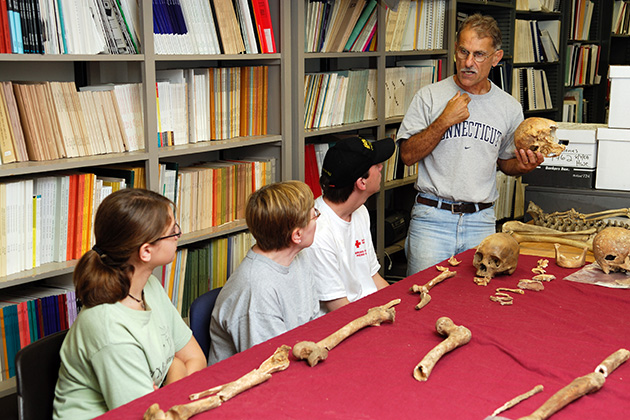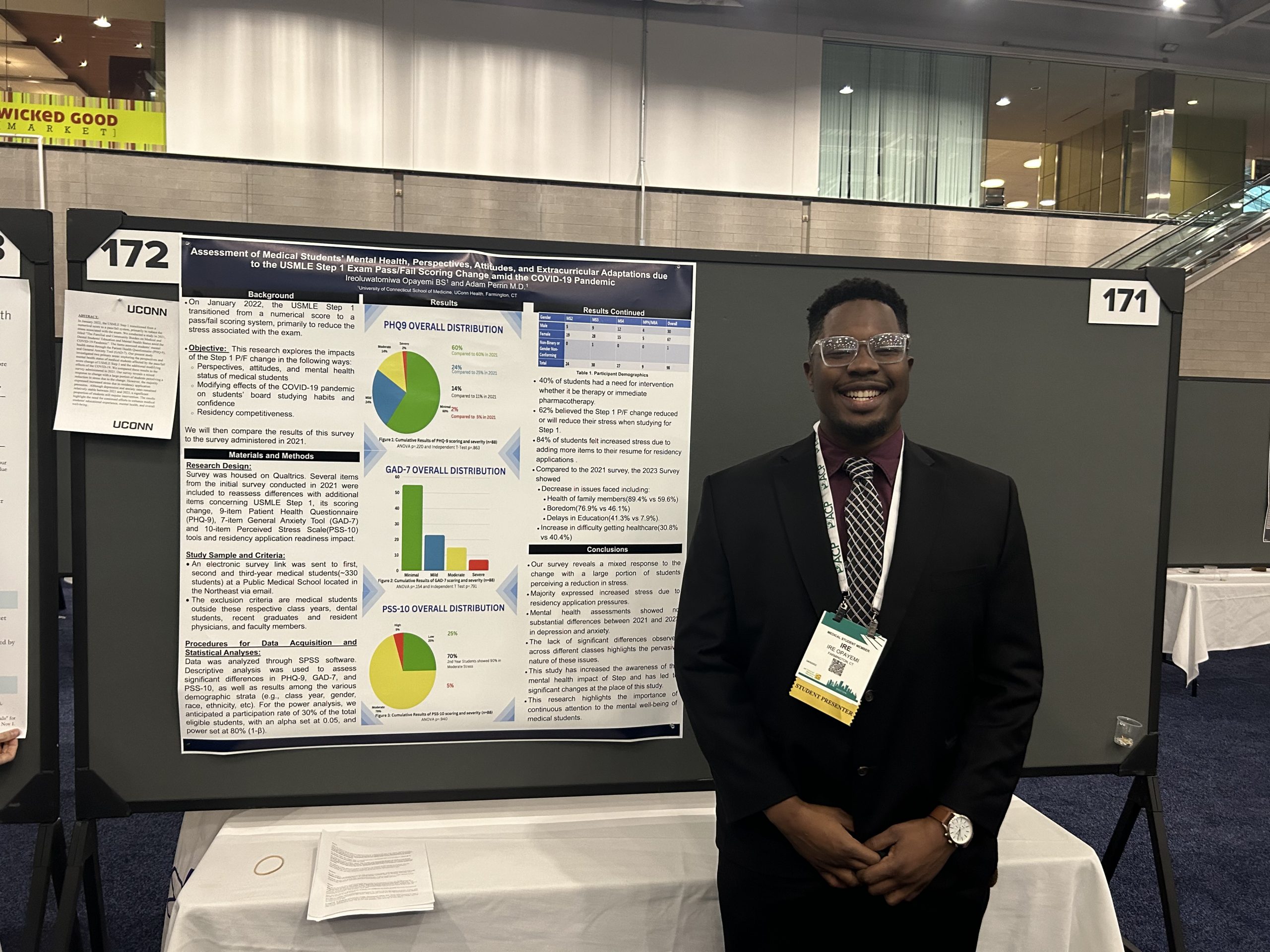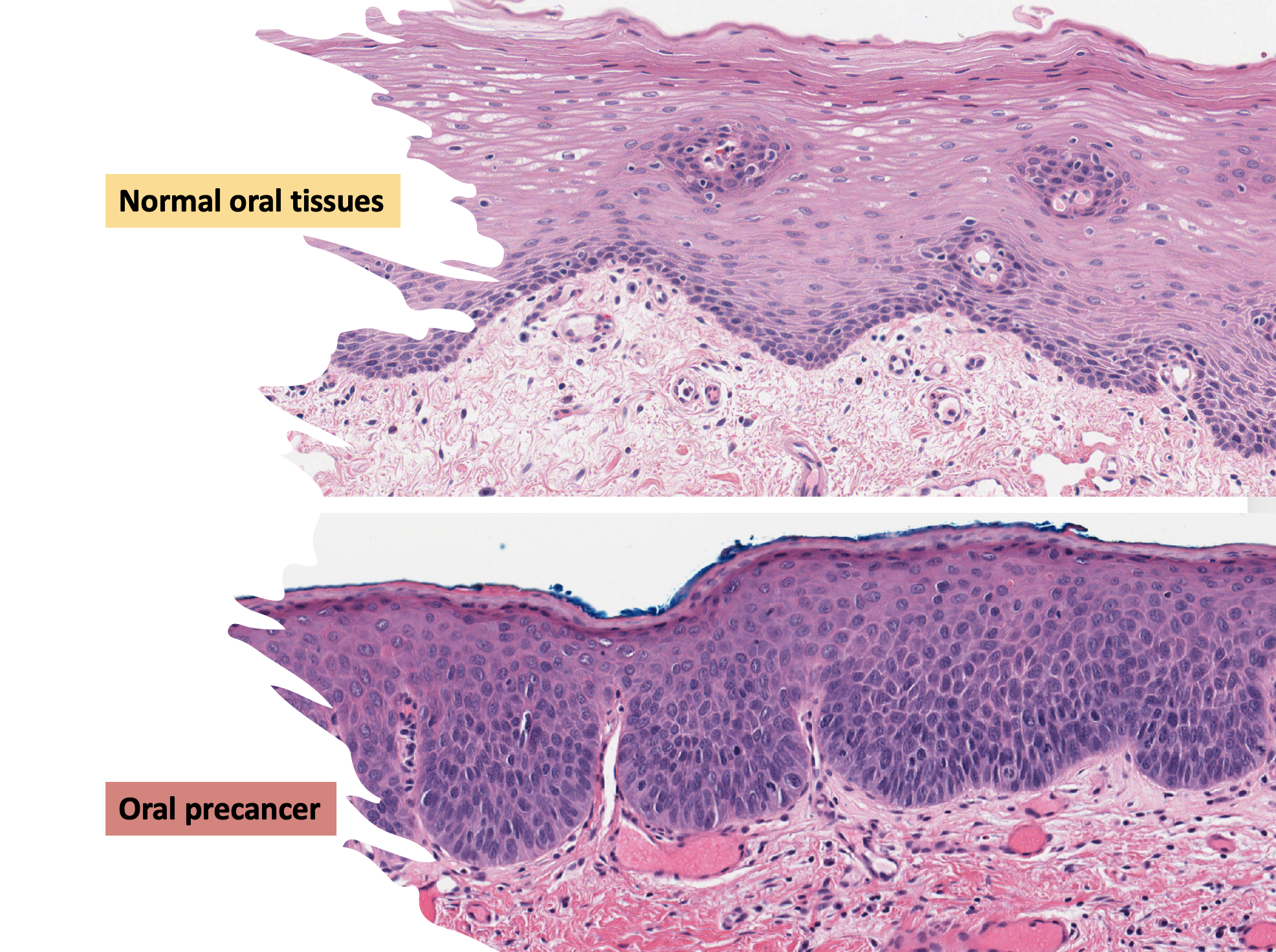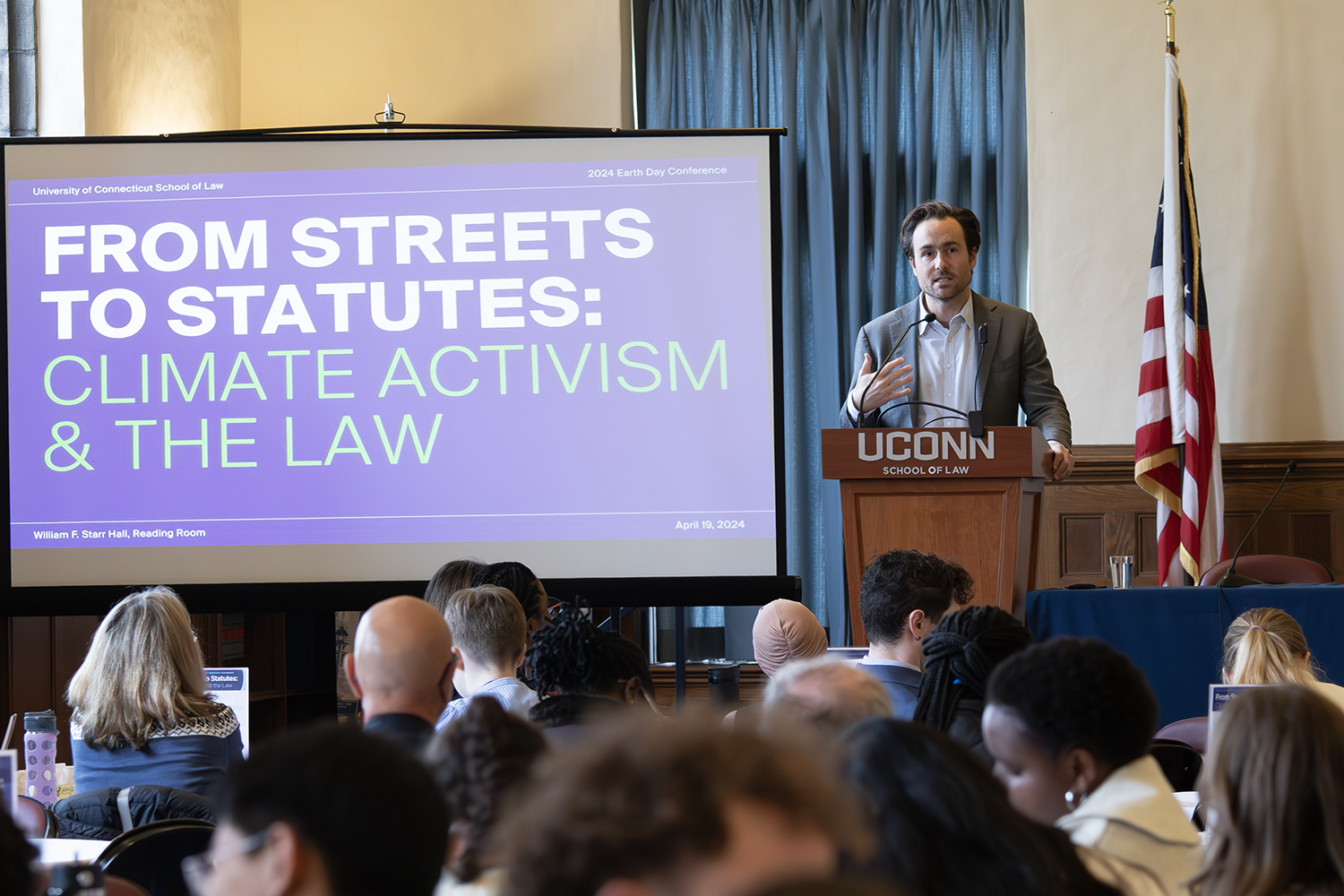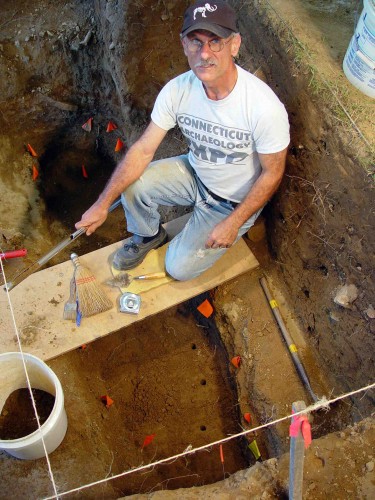
As State Archaeologist with the Connecticut State Museum of Natural History and Archaeology Center in the College of Liberal Arts and Sciences since 1987 and a faculty member in the Department of Anthropology, Nicholas Bellantoni has been one of the most prominent faces of science in the state, tirelessly advocating for the preservation of historically important sites and speaking to schools, community groups, and the media about the blend of forensic science, history, and detective work that go into his job description.
Now, as he prepares for his retirement this summer (“I’m looking forward to actually writing some of this down,” he jokes), Bellantoni took some time in his office – half archaeologist’s nest, half shrine to Frank Sinatra – to reflect on some of his most memorable projects.
“It’s difficult to narrow down everything I’ve had a chance to work on into a few highlights,” he says. “Sooner or later, though, everyone asks about Hitler and the vampires.”
The vampires: of course. But there’s much more to the work of a state archaeologist than creatures of the night, as Bellantoni explains:
The Repatriation of Albert Afraid of Hawk
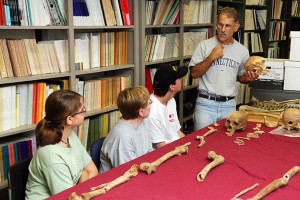
When Nicholas Bellantoni came to the University of Connecticut in 1979 as a graduate student, he didn’t imagine he’d spend the next 35 years here, let alone that his research would lead to projects that ranged from the repatriation of Native American remains to the examination of a skull fragment supposedly belonging to Adolf Hitler, and countless stops in between.
A 20-year-old Lakota Sioux who performed in Buffalo Bill’s Wild West Show, Albert Afraid of Hawk, died from botulism poisoning in Danbury in 1900, where the famous traveling exhibition was performing. Afraid of Hawk was left in an unmarked grave for over a century, until local historian Robert Young identified the burial location.
Young contacted Afraid of Hawk’s family, who live on the Pine Ridge Reservation in South Dakota, but it wasn’t until the dead man’s grandniece, Marlis, had a dream about her ancestor that the family decided it was time for Albert to come home.
As State Archaeologist, Bellantoni was called in to exhume the remains in 2012. While family members looked on, he found skeletal remains remarkably preserved despite the acidic soil, which were reinterred during a ceremony at Pine Ridge that September. Before the delegation from the reservation left, they bestowed the Lakota name Tapu wan Waste Okile on Bellantoni, which means “He Who Finds Good.”
“What made that so special is that we worked so closely with his family,” Bellantoni says. “Archaeology isn’t just ancient history, it’s contemporary people, and their hopes and expectations.”
The Story of Venture Smith, ‘The Black Paul Bunyan’
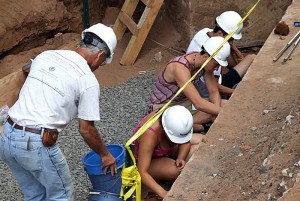
Born in what is now Ghana, Smith was kidnapped and sold into slavery in New England in the 18th century. Eventually purchasing his own freedom as well as the freedom of his wife and children, Smith went on to become a wealthy landowner, with holdings that included a Long Island boat yard, land in Africa, and a 300-acre farm in East Haddam.
But it was his autobiography, dictated to a local schoolteacher and published in 1798, that secured his place in American history. One of the earliest pieces of writing by a black American, the memoir has been a valuable tool for researchers ever since its publication, but no one has been entirely sure what to make of the folklore-like tales that sprang up about Smith’s vast size and strength.
In 2006, after UConn researcher Linda Strausbaugh began doing DNA work with Smith’s descendants, Bellantoni and a team of international researchers worked with Smith’s descendants to exhume some of the graves in the burial plot. While not much remained, they were able to fill in some likely details about the family’s high status in the community at the time, along with Smith’s size – the one-time lumberjack was likely 6’2” and over 300 pounds, practically a giant by 18th-century standards.
“I don’t work to protect artifacts and sites, I work to protect heritage,” Bellantoni says. “Working with living family members really shows you that the past has a profound impact on how people think of themselves.”
The Unearthing of a Jewish Ritual Bath in Eastern Connecticut
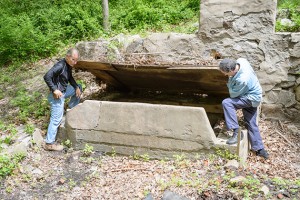
Working with Stuart Miller, academic director of the Center for Judaic Studies and Contemporary Jewish Life at the University, Bellantoni excavated a forgotten mikveh, or ritual bath house, in an abandoned settlement that had once been a thriving Jewish community in early 20th–century Connecticut.
The significance of the find was twofold: first, for showing that Eastern European Jewish immigrants in the late 19th century were more religious than historians had believed, and second for the unlikely fact of the mikveh itself, an example of which had never been found outside a major U.S. city before.
Working once again with descendants – in this case, the New England Hebrew Farmers of the Emanuel Society – Bellantoni was able to secure the site’s inclusion on the National Register of Historic Places.
“One of the biggest mistakes people make is they think there’s no archaeology to be done in Connecticut,” he says. “It’s not ancient Rome, you know, that kind of thing. But what I’ve found in my career is the incredible diversity, as well as the richness, of archaeological sites here. I’ve learned to expect the unexpected.”
The Remains – or Not – of Adolf Hitler
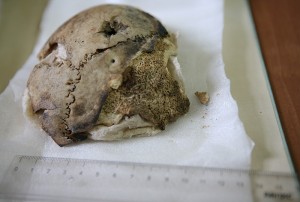
Although Bellantoni works primarily in Connecticut, his role as State Archaeologist has given him expertise in forensic science that can be applied anywhere human remains are found. The most dramatic illustration of this was when he – along with UConn faculty members Linda Strausbaugh and Dawn Pettinelli – were enlisted by the History Channel in a documentary about the remains of Nazi dictator Adolf Hitler.
As World War II drew to a close, the Soviet Red Army reached the location of Hitler’s bunker after his suicide. While the Soviets always officially denied they had found Hitler’s remains, a skull fragment with a bullet wound sent back to the Russian national archives in Moscow had long been believed to be that of the dictator. Bellantoni conducted an exploratory dig in Germany, and gained access to a wealth of evidence in Moscow, including DNA from bone and blood fragments.
DNA testing by Strausbaugh and soil testing by Pettinelli established definitively that the remains in Moscow don’t belong to Hitler, although Bellantoni is quick to dismiss any theories that suggest Hitler didn’t die in his Berlin bunker in 1945.
“That was a good example of taking skills I had developed here and transplanting them to a new environment,” Bellantoni says. “I’m not an expert on the Third Reich, but I know how to put a shovel in the ground.”
And the Vampires
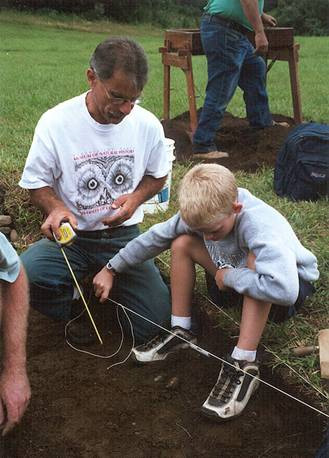
They weren’t actually vampires, of course. Along with Rhode Island folklorist Michael Bell, Bellantoni peeled back the curtain on a forgotten folk belief that once gripped New England rural communities struggling with tuberculosis in the 18th and 19th centuries.
In eastern Connecticut, western Rhode Island, and parts of southern Vermont settled by Connecticut residents, some people believed that the first member of a family to die from the illness then called “consumption” was returning, after death, to infect other family members.
To thwart this, people exhumed the bodies of the supposed revenant and enacted a grisly variety of procedures to prevent their returning from the grave: some were beheaded, some had their hearts removed and burned, some had femur bones broken and crossed over their chests.
A chance discovery by children in Griswold of bones from a forgotten cemetery is what led Bellantoni onto the path that has been discussed in films, books, newspaper articles, and television shows all over the world. Almost 25 years after that Griswold discovery, he still gets phone calls and emails about the vampires.
“I use it as a way to teach history and forensics,” he says. “People really believed this, and they acted on their beliefs. It wasn’t that long ago, either – Michael Bell has started to find cases from the early 20th century.”
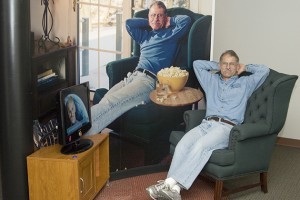
Although he’ll be retired as State Archaeologist, with Brian Jones ’98 Ph.D. joining the museum as his successor, Bellantoni will still be involved in the work of the museum, and plans to teach a class or two.
“One of the unexpected benefits of this job is that I know somebody in every town in the state of Connecticut,” he says, “whether it’s a former student, a museum volunteer, someone we worked with on a project, or a local official involved in preservation efforts. That’s really been a great joy, and it’s one of the many reasons I’m tremendously grateful to have done this job.”
